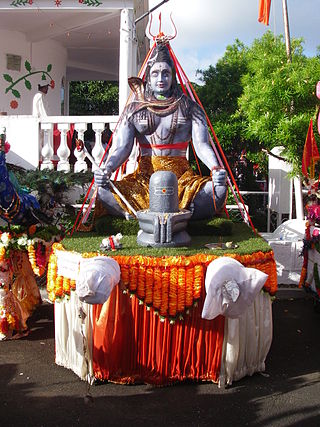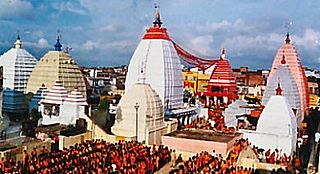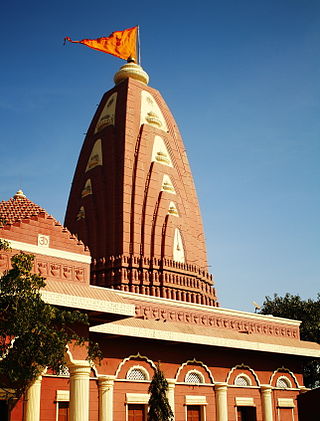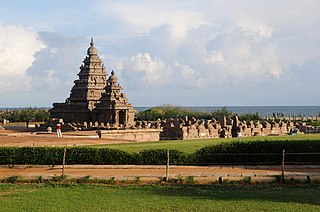
The Elephanta Caves are a collection of cave temples predominantly dedicated to the Hindu god Shiva, which have been designated a UNESCO World Heritage Site. They are on Elephanta Island, or Gharapuri, in Mumbai Harbour, 10 kilometres (6.2 mi) east of Mumbai in the Indian state of Mahārāshtra. The island, about 2 kilometres (1.2 mi) west of the Jawaharlal Nehru Port, consists of five Hindu caves, a few Buddhist stupa mounds that date back to the 2nd century BCE, and two Buddhist caves with water tanks.

Maha Shivaratri is a Hindu festival celebrated annually in honour of the deity Shiva, between February and March. According to the Hindu calendar, the festival is observed on the fourteenth day of the first half of the lunar month of Phalguna. The festival commemorates the wedding of Shiva and Parvati, and the occasion that Shiva performs his divine dance, called the Tandava.

The Srikalahasti Temple is located in the town of Srikalahasti, in Tirupati district in the state of Andhra Pradesh, India. According to regional tradition, it is said to be the site where Kannappa was ready to offer both his eyes to cover blood flowing from the linga before Shiva stopped him and granted him moksha. The inner temple was constructed around the 5th century CE and the outer temple was constructed in the 11th century by the Rajendra Chola I and other Chola emperors such as Rajaditya Chola, Rajaraja Chola I, Rajadhiraja Chola I, Kulottunga Chola I, Kulottunga Chola III. And Vijayanagar Empire. The 120 feet (37 m) high main gopuram and the hundred pillared hall with intricate carvings was commissioned during the regime of the Vijayanagara Krishnadevaraya during 1516 CE. Shiva in his aspect as Vayu is worshipped as Kalahasteeswara. The temple is also regarded as Rahu-Ketu kshetra and Dakshina Kailasam.

Omkareshwar Temple is a Hindu temple dedicated to Shiva, located in Mandhata, nearby Khandwa city in Khandwa district of the Indian state of Madhya Pradesh. It is one of the 12 revered Jyotirlinga shrines of Shiva. It is on an island called Mandhata, near Khandwa city in the Narmada River at Khandwa district in Madhya Pradesh, India; the shape of the island is said to be like the Devanagari ॐ symbol.

Draksharamam or Daksharamam (దక్షారామం) is one of the five Pancharama Kshetras that are sacred to the Hindu god Shiva and also 12th of Ashtadasha Shakthi Peetams. The temple is located in Draksharamam town of Konaseema district in the Indian state of Andhra Pradesh. Bhimeswara Swamy refers to Lord Shiva in this temple. Poet Mallikarjuna Panditaradhyudu who wrote first independent work in Telugu and who spread Veerasaivism in Andhra region during medieval ages was born in this town.

Ksheerarama is one of the five Pancharama Kshetras that are sacred to the Hindu god Shiva. The temple is located in Palakollu of West Godavari in the Indian state of Andhra Pradesh. Shiva is known locally as Ksheera Ramalingeswara Swamy. It is believed that staying one day in Kshirarama is equivalent to staying one year in Varanasi. It is one of the centrally protected monuments of national importance.

Kumararama or Bhimarama is one of the five Pancharama Kshetras that are sacred to the Hindu god Shiva. The temple is located in Samalkota of Kakinada district in the Indian state of Andhra Pradesh. The other four temples are Amararama at Amaravati(Dist. Guntur), Draksharama at Draksharama, Ksheerarama at Palakollu and Somarama at Bhimavaram(both in Dist. West Godavari). It is one of the centrally protected monuments of national importance.

Srisailam is a census town in Nandyal district of the Indian state of Andhra Pradesh. It is the mandal headquarters of Srisailam mandal in Atmakur revenue division. It is located about 160 kilometres (99 mi) from the district headquarters Nandyal, 180 kilometres (112 mi) from Kurnool, and it is located about 264 kilometres (164 mi) from Vijayawada. The town is famous for the Mallikarjuna Jyotirlinga Temple and is one of the holy pilgrimage sites for the Shaivism and Shaktism sects of Hinduism. The town is classified as both a Jyotirlinga and a Shakta pitha.

Baidyanath Temple, also known as Baba Baidyanath Dham, is a Hindu temple dedicated to Shiva. It is located in Deoghar, in the Santhal Parganas division of the Indian state of Jharkhand. The temple complex comprises the central shrine of Baba Baidyanath along with 21 additional temples. It is significant to the Hindu sects of Shaivism as this temple is referred to as one of the twelve Jyotirlingas.

Odela is a village in Odela mandal of Peddapalli district of the Indian state of Telangana. Odela Mallikarjuna swamy devasthanam is one of the popular pilgrimage centers in Telangana. Every year in summer thousands of people will come visit the temple from all over the Telangana and Andhra Pradesh. Sri Mallikarjuna Swamy temple of Lord Shiva is located about 2 km from the Odela village and Mandal, Peddapalli District in Telangana, India.

Andhra Pradesh is a state in India. Andhra Pradesh Tourism Development Corporation (APTDC) is a state government agency which promotes tourism in Andhra Pradesh, describing the state as the Koh-i-Noor of India. Andhra Pradesh has a variety of tourist attractions including beaches, hills, caves, wildlife, forests and temples.
Nagarjunsagar-Srisailam Tiger Reserve is the largest tiger reserve in India. The reserve spreads over five districts, Nandyal District, Prakasam District, Palnadu District, Nalgonda District and Mahabub Nagar district. The total area of the tiger reserve is 3,728 km2 (1,439 sq mi). The core area of this reserve is 1,200 km2 (460 sq mi). The reservoirs and temples of Srisailam are major attraction for many tourists and pilgrims. It is the largest tiger reserve forest in India and is located inside Nallamala forest area.

Nageshwar Temple is a Hindu temple dedicated to the Hindu god Shiva located on Dwarka, Gujarat, India. one of the legendary temples mentioned in the Shiva Purana and is one of the twelve Jyotirlingas. Nageshvara jyotirlinga is situated in a forest called Daarukavanam In Gujarat

Sri Bhramaramba Mallikarjuna Temple or Srisailam Temple is a Hindu temple dedicated to the deities Shiva and Parvati, located at Srisailam in the Indian state of Andhra Pradesh. It is significant to the Hindu sects of both Shaivism and Shaktism as this temple is referred to as one of the twelve Jyotirlingas of Shiva and as one of the eighteen Shakti Pithas, centres of the Hindu Goddess. Shiva is worshiped as Mallikarjuna, and is represented by the lingam. His consort Parvati is depicted as Bhramaramba.

Pallikondeswara Temple(also Pradosha kshetram) is a Hindu temple dedicated to the god Shiva located in Surutupalle, a village in Tirupati district of Andhra Pradesh, India. The presiding deity Pallikondeswara, unlike other Shiva temples, is sported in reclining posture lying on the lap of his consort Parvati.

Bhairava Ashtami, also known as Bhairavashtami, Bhairava Jayanti, Kala-Bhairava Ashtami and Kala-Bhairava Jayanti is a Hindu holy day commemorating the manifestation of the deity Bhairava, a fearsome and wrathful manifestation of the god Shiva. It falls on the eighth lunar day (ashtami) in the fortnight of the waning moon in the Hindu month of Kartika or Margashirsha. By both schemes, Bhairava Ashtami falls on the same day in November–December-January. The name Kalashtami is sometimes used to refer to this day, but might also refer to any ashtami in Krishna paksha, all of which are days sacred to Bhairava.

The Group of Monuments at Mahabalipuram is a collection of 7th- and 8th-century CE religious monuments in the coastal resort town of Mahabalipuram, Tamil Nadu, India and is a UNESCO World Heritage Site. It is on the Coromandel Coast of the Bay of Bengal, about 60 kilometres (37 mi) south of Chennai.
Tripuranthakeswara Temple is a Hindu temple dedicated to the deity Shiva, located at Tripuranthakam in Prakasam district, Andhra Pradesh, India.
























